Author : Barry Tyler
When a vessel is categorised as ‘perfect for charter’ one immediately conjures up an image of a plain Jane, no frills, bullet-proof, idiot-proof style of vessel that while being totally practical from a user perspective, invariably always lacks the unashamed luxury and appointments of a vessel bound for a private owner. There are however exceptions to that blanket character assassination and one stand-out example that caters equally well to both markets, is the Leopard range of power and sailing catamarans.
Built by world-renowned South African boat-building manufacturer Robertson and Caine, Leopard the number one selling catamaran in North America is already well respected around the South Pacific as well. As prolific manufacturers of both power and sailing versions to the cruising world as well as the worldwide charter industry, Robertson and Caine have fine-tuned the various models to such a high level of specification and presentation that there is now little difference in their range, between charter and private specification with the exception of the configuration and the list of high quality extras that can be ordered on the private models.
As such, their marketing emphasis has now been expanded to meet the private sectors demand in Australasia. “The major difference between charter and private is the cabin configurations. Four-cabin layouts work extremely well in the charter industry, whilst the three-cabin layout is often the preferred owners version. The starboard hull is entirely dedicated to the owner, with a large private cabin, study area, separate head and shower room,” LCA David Flynn explained, “.
Even viewed from the pier the Leopard 474 PC was one of those boats that stood out in a crowd. Robertson and Caine has proved beyond question the humble catamaran configuration can look stylish, that it doesn’t have to be all square corners and high hull and topsides. Step aboard though and you are left in no doubt that innovation too is still very much alive and kicking in the boatbuilding business.
The builders have obviously listened and reacted to market trends and expectations and the net result is a vessel that is as close as you can get to being all things to all people. The fact this vessel is a brand new model, ostensibly offering an alternative to the Leopard 46 sailing version, suggests they have learned too that (efficient) ‘power’ is fast becoming the preferred option for many cruising boaters.
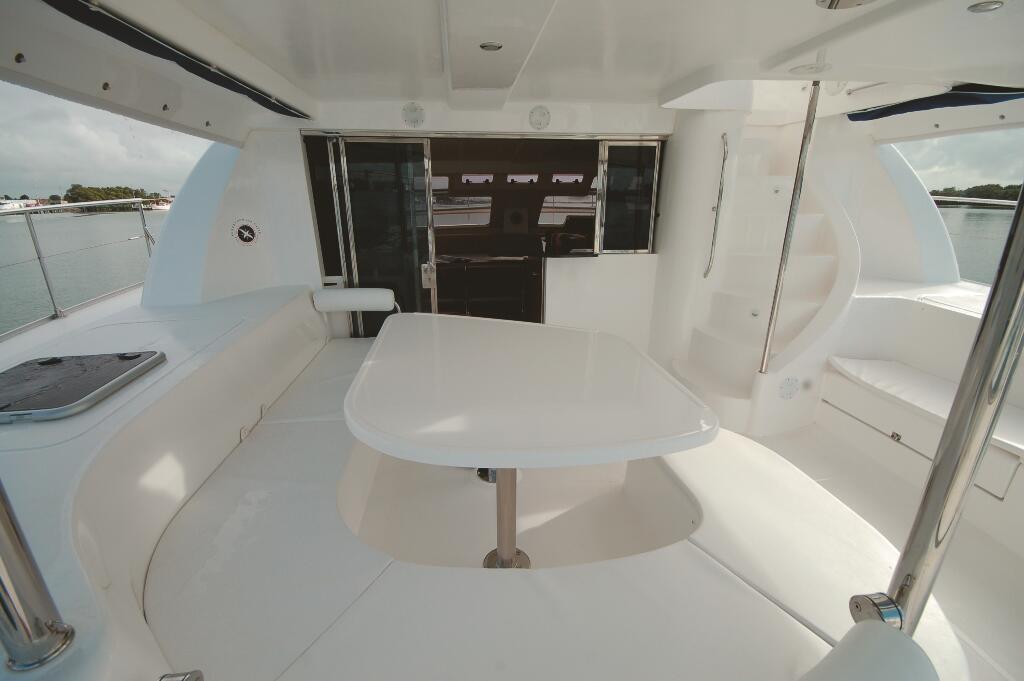
The Epitome of Lifestyle Living
Cruising boaters are a very different breed to your rank and file day-boater; they are invariably more particular, more knowledgeable and therefore more discerning. These owners know what they want in a boat and the cockpit for starters was surely indicative of the fact the builders have made every endeavour to accommodate the concept of the ideology that is long-range cruising. Boarding was easy, it was low enough to the water to be of practical use for swimmers and divers, and the steps led you easily up onto the cockpit level.
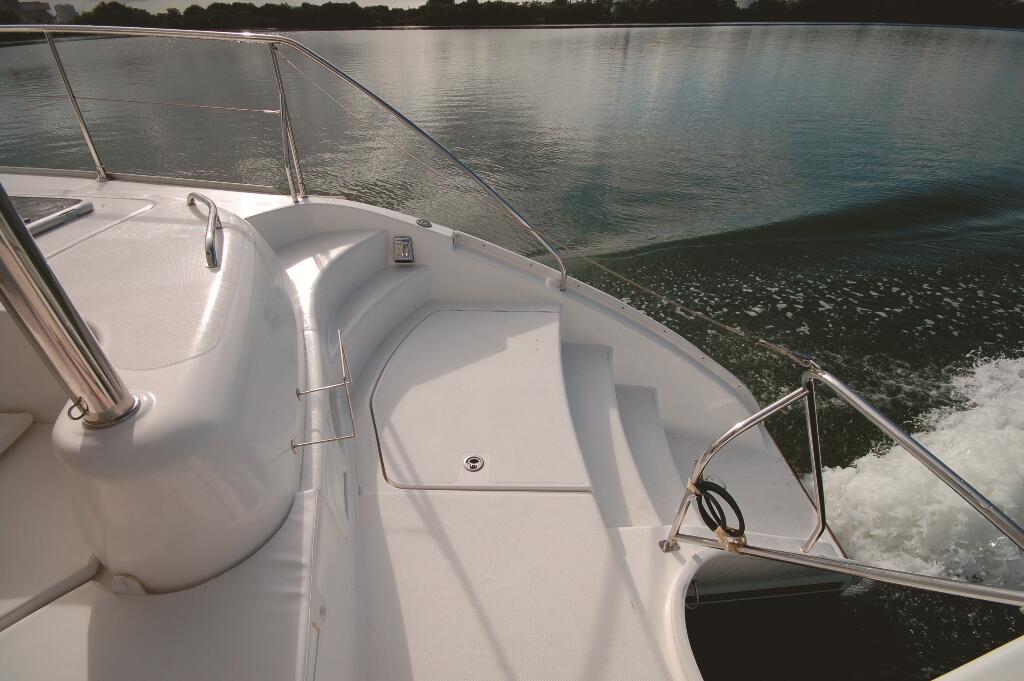
Special effort for instance had been made to separate the entertaining part of the cockpit from the ‘working’ area aft of the transom beam (upright), but what impressed me most was the thought and attention that had so obviously gone into the actual moulding of the entire aft end. The shapes, edges and features, even down to the integral rear tender davits, were all very easy on the eye. Wherever you wanted to sit, there was a seemingly appropriate place for every situation. Idyllic, I think they call it!
And if you couldn’t find an appropriate ‘mood’ location there the convenient steps and wide walkways, complete with inner grab rails and a substantial bow rail assembly, beckoned you up onto a well encapsulated foredeck area. The stylish (futuristic) louvered front windscreen panels made a great seating position when underway and while this was a charter version and therefore devoid of it in that instance, a padded sun-lounge on the flat foredeck would be perfect for the sun-worshippers.
Most guests however would probably gravitate to the flybridge level, taking the entirely safe semi-spiral staircase up to enjoy the sensation of the ride with the skipper. A single helm station vessel in this instance, the skipper and two others enjoy a commanding view of all corners of the vessel. From an electronics perspective the helm was surprisingly well spec’d with a Raymarine integrated sounder and GPS package complementing the Seastar hydraulic steering and the Volvo instrumentation and remote controls.
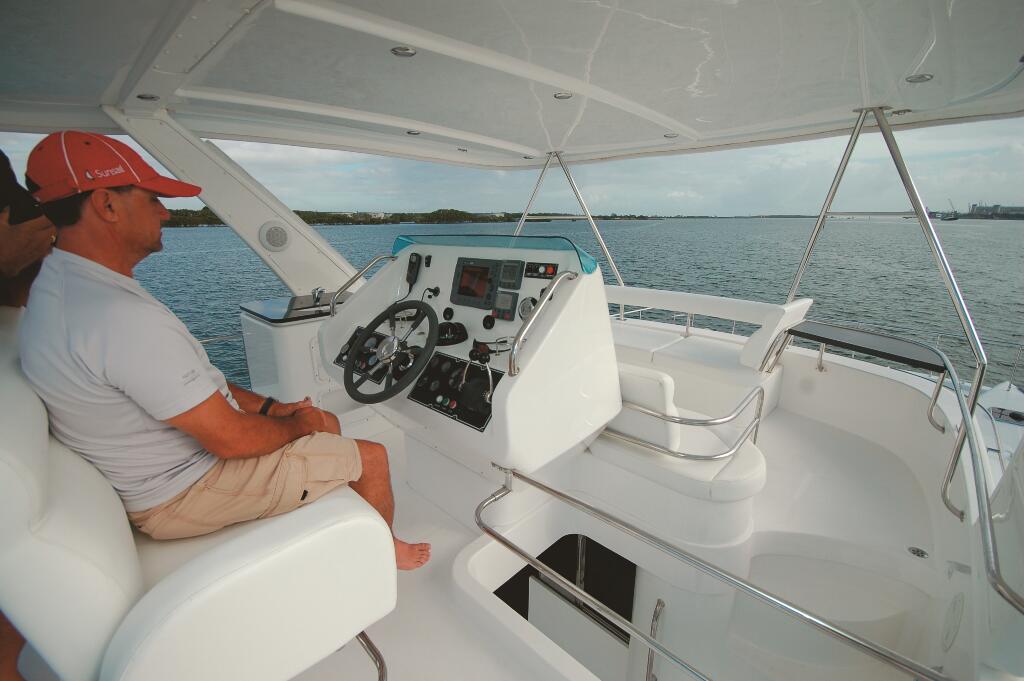
Forward of the helm module was the guest area and again it was a tasteful combo of innovation, curves and rounded corners that softened the often stark look of a gelcoat finish. I would best describe this as a classy rather than outright opulently luxurious level, but none-the-less once you got up here, grabbed a drink from the wet-bar and laid back in the forward lounge – you would never want to leave! Should it rain or blow hard, the open-hardtop setting can instantaneously be enveloped with a set of quick-fit clears around all four sides.
Spacious Saloon
With so much space devoted to the outdoor lifestyle aspect, I was more than a little surprised at how capacious the saloon actually was. The most convenient aspect of a catamaran configuration I guess is the fact that to change from a three- to four-cabin layout impinges nought on the saloon space above.
Wrong, very wrong, for immediately a number of marques spring to mind that definitely do not take anywhere near full advantage of potentially ‘available’ space. I am happy to say however that this was not the case with the Leopard for they had been able to include all the expected features – and still have uncluttered space left over.
The galley was to starboard as you entered through the sliding S/S doors, with a really nice touch being the fold-down bench extension that was perfect when laying out the ‘nibbles’ for guests ‘reclining’ out in the cockpit. Another pleasant surprise was not only the size of the galley, but its specification. Plenty of bench space, plenty of cupboards and drawers; and standard features such as microwave, house-size oven and four-burner gas stove, dishwasher and twin sinks. Seemingly ambidextrous, it was perfect for a long-range cruising situation – or for a charter situation with four couples aboard.
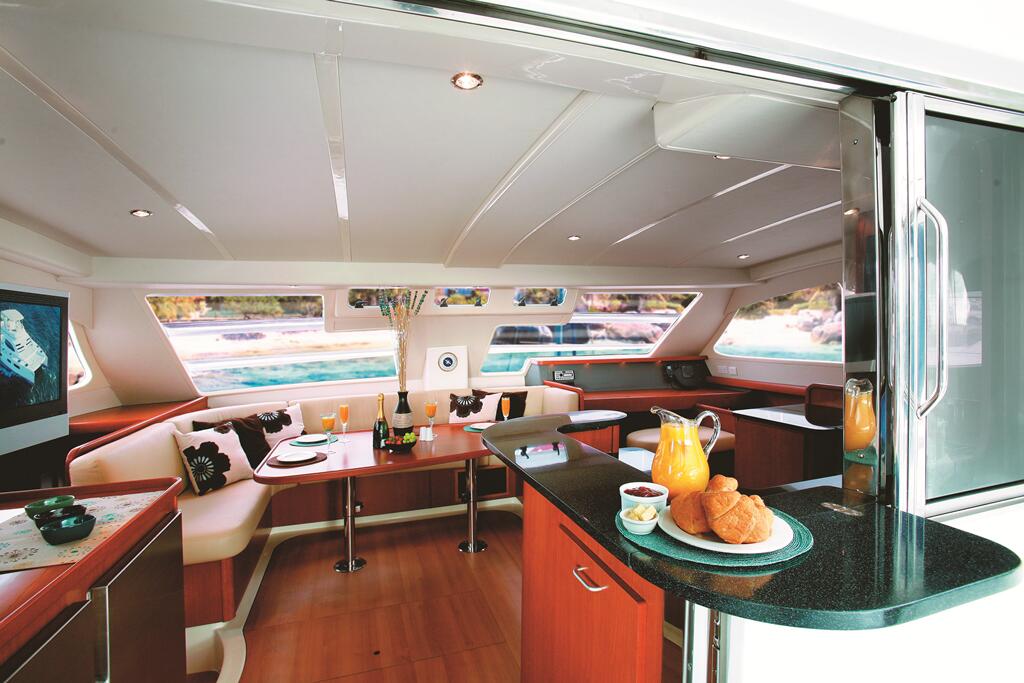
An obviously integral appointment within the saloon was the generous-sized genuine six-person (eight with a squeeze) dining setting across the front bulkhead – it set the mood so to speak. On the end of this dining setting was a pseudo work-station or chart table, complete with a leather side seat.
Still room left? You betcha, for to port and just inside the saloon doors was another impressive cherrywood module that housed the appropriately-sized refrigerator and separate freezer and above it, a servery, a cantilevering laser TV and behind the glass doors, the AC/DC switch panel and ‘entertainment’ facia. Compact where it needed to be, expansive where it needed to be, but the point was it was all neatly and effortlessly dove-tailed into this most impressive saloon.
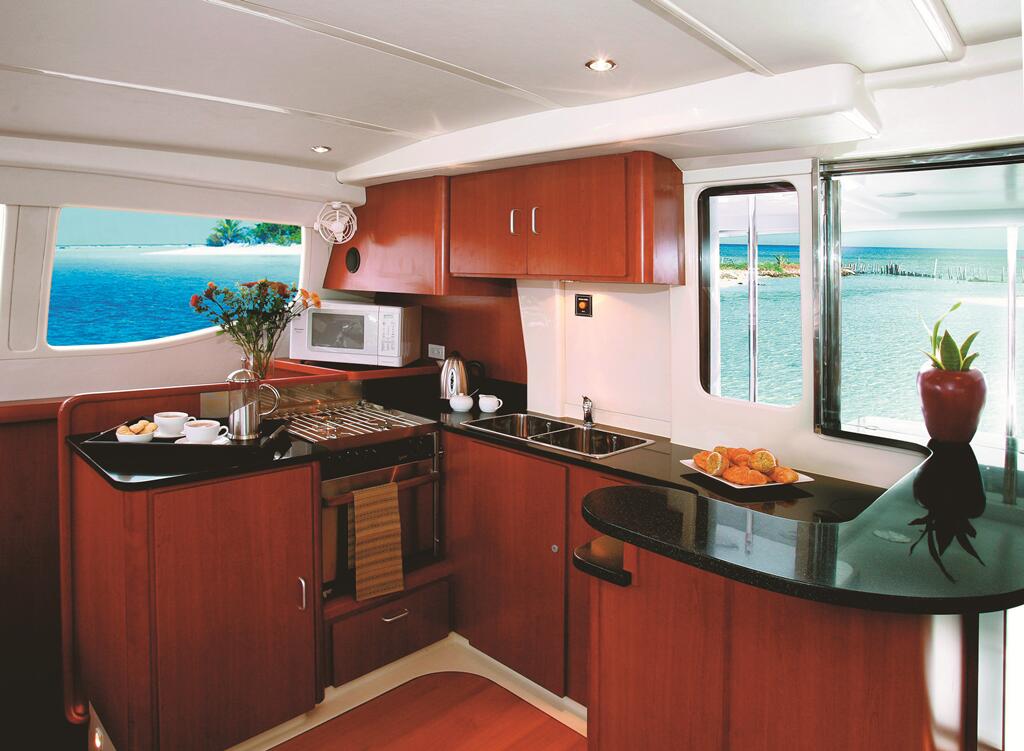
‘Equal Billing’ Below Decks
Below decks, as previously stated, the layout options were either three or four completely private (that’s important) cabins, each with its own attached ensuite that included vanity, separate shower and Jabsco electric macerator head. In the instance of the three-cabin version, the starboard side becomes the master’s side and the forward bedroom and central ensuite are replaced by a study and a larger bathroom forward of that again.
An observation from the outside confirmed my impressions once below; all four cabins in our test boat were light, bright rooms courtesy of the generous portside windows and the overhead Lewmar hatches. Décor was a tasteful combination of cherrywood timber, vinyl panels and some gelcoat, but the best aspect for me was the fact that both the for’ard and aft cabins in this four-cabin version were virtually the same as regards dimension, appointments, layout and décor.
Even the (queen-size) berths were the same – apart from the fact there was a little more room either side of the berths in the aft cabins, for ease of ‘making’ the beds. That was compensated however by the fact that the two forward cabins included a single berth forward of the queen-size berth – great for a family situation.
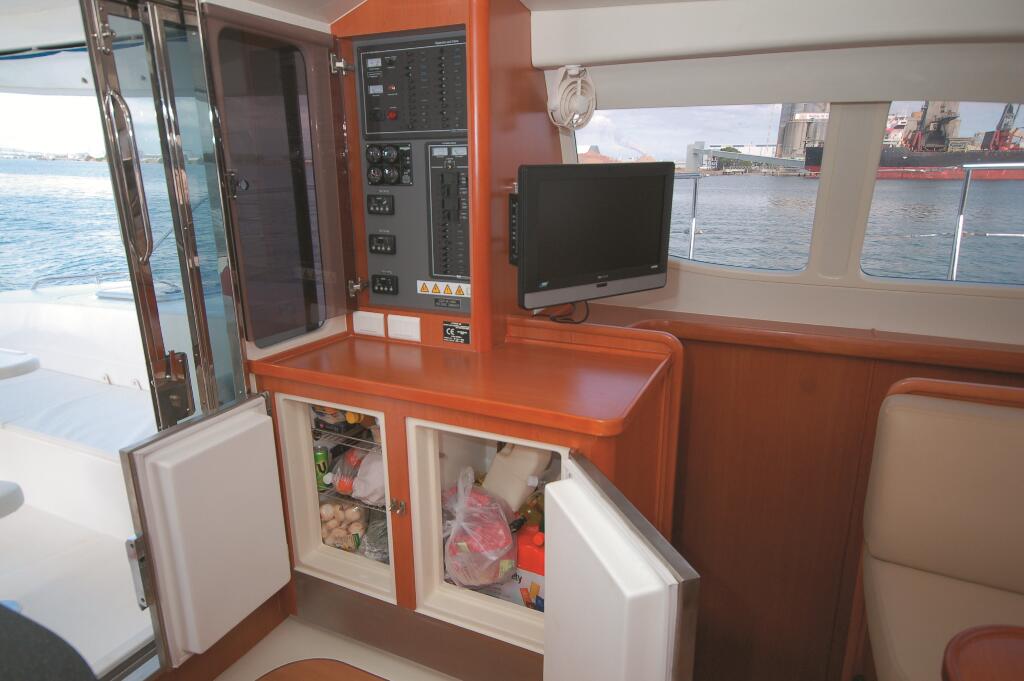
Also within the confines of the aft cabins was direct access to the engines. Down in the aft cabins while underway certainly YES, you could hear the engines ‘beating their drums’ but NO, it most definitely was not onerously noisy, for the insulation did a very good job. Just on the engines, power for this particular ‘charter’ version was twin 225hp Volvo D225 diesel engines through Volvo gearboxes and conventional shaft drive, to the 4-blade 21”D x 25”P nickel-bronze propellers.
The other engine options recommended for this model are either the smaller 150hp Cummins diesels (max. 18 knots), or at the other end of the scale the 260hp Volvo Penta diesels (max. 22.5 knots). It really depends on what your usage and expectations are but sensibly LCA have bisected the two with in this instance power courtesy of 225hp Volvo examples which returned a top speed of 21 knots at the maximum 3500rpm. Figures I suggest that graphically accentuate the efficiency of this 14,500kg GRP catamaran.
As in the rest of the vessel, Robertson and Caine had done a very effective job of maximising space when housing the tankage and all the mechanical peripherals – so the boat was well balanced fore and aft. Aft of the engines and accessed through the rear cockpit hatches were the two 600-litre fuel tanks, the Cruisair air-conditioning, the fire extinguisher system, the three 210Ah AGM deep cycle house and two engine batteries, and the Mastervolt battery chargers, inverters and shore power.
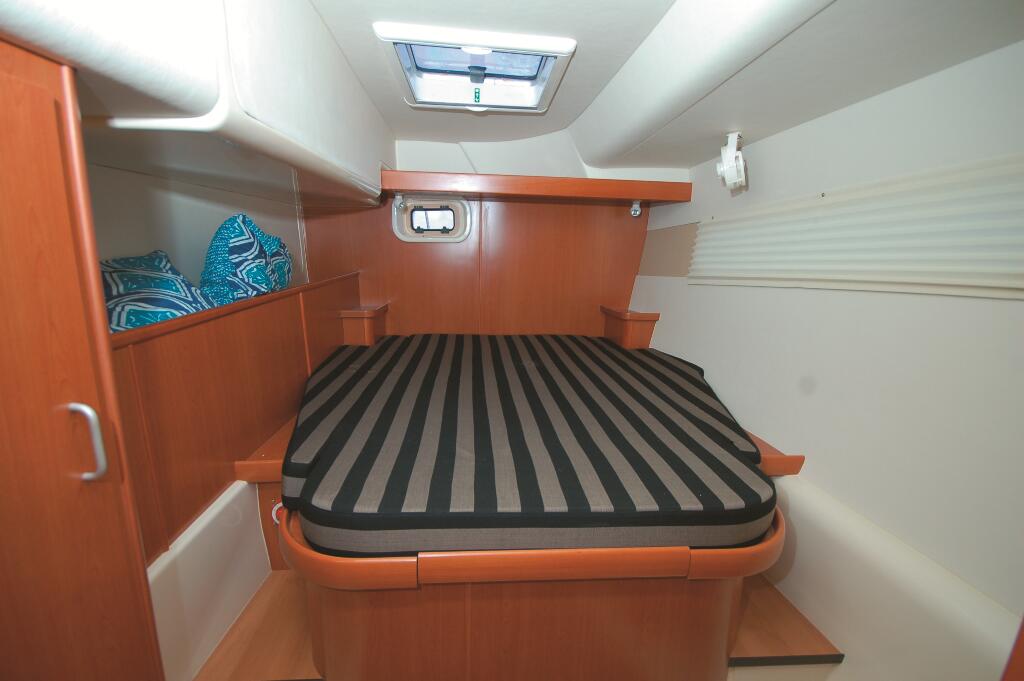
Forward of the engines and virtually amidships were the two 500-litre water tanks and then up in the well sealed cavernous bow lockers on the foredeck we discovered in the portside locker a Northern Lights 9kVA generator. The starboard-side locker was empty in this charter instance but of course it would lend itself nicely to a convenient ‘home’ for a desalinator or a dive compressor. Bisecting these two deck lockers was a cover that when lifted revealed the Lofrans windlass and guide channel to the Delta and Brittany anchors secreted under the bow beam – I mean to say, you certainly would not want a messy old anchor chain running right through the middle of your sun-bathing area, would you!
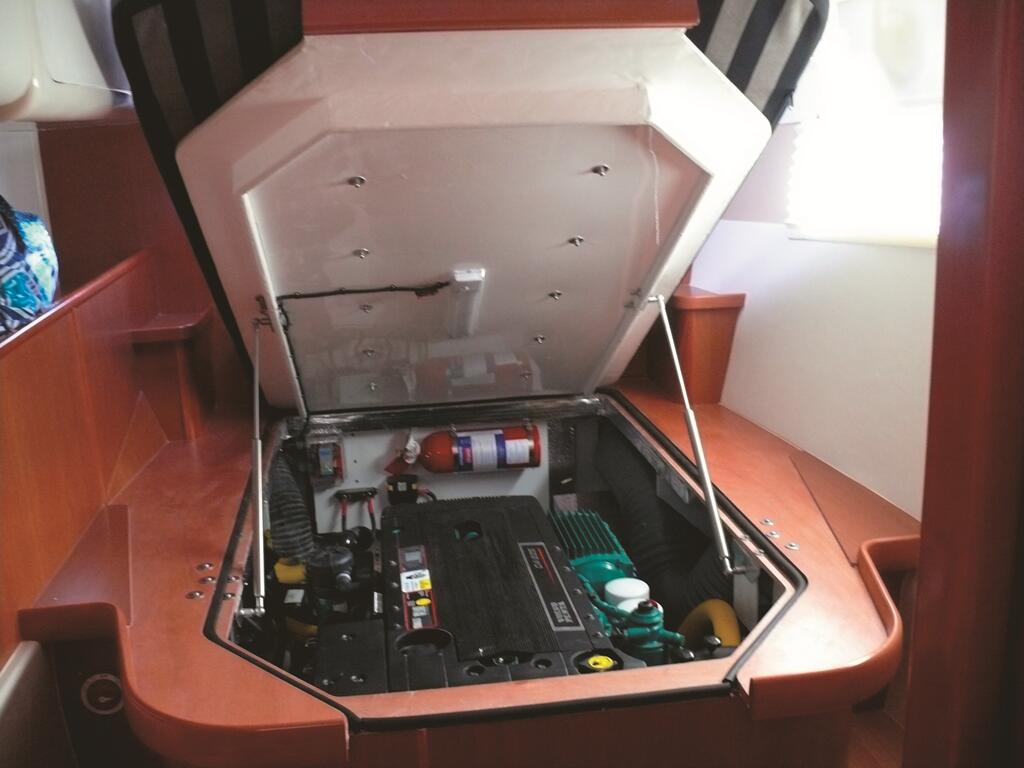
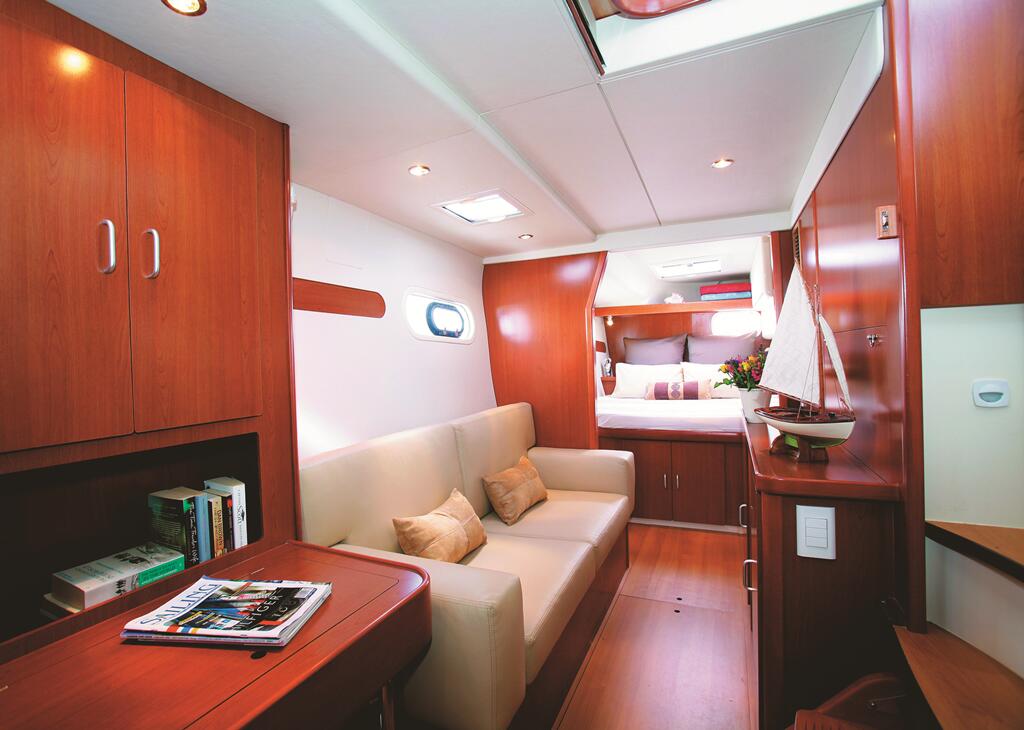
Conclusion
Forget about the fact that this vessel was destined for the charter industry – the Leopard 474PC was quite simply the consummate cruiser, with may I add styling, specification, efficiency, and class! It was certainly a breath of spring air to go aboard a boat that while practical, still had the styling of a European sports cruiser. It looked the part and it certainly embraced the typical ideology of lifestyle boating. Consider the price of $A1.2million, and what you get for that money!
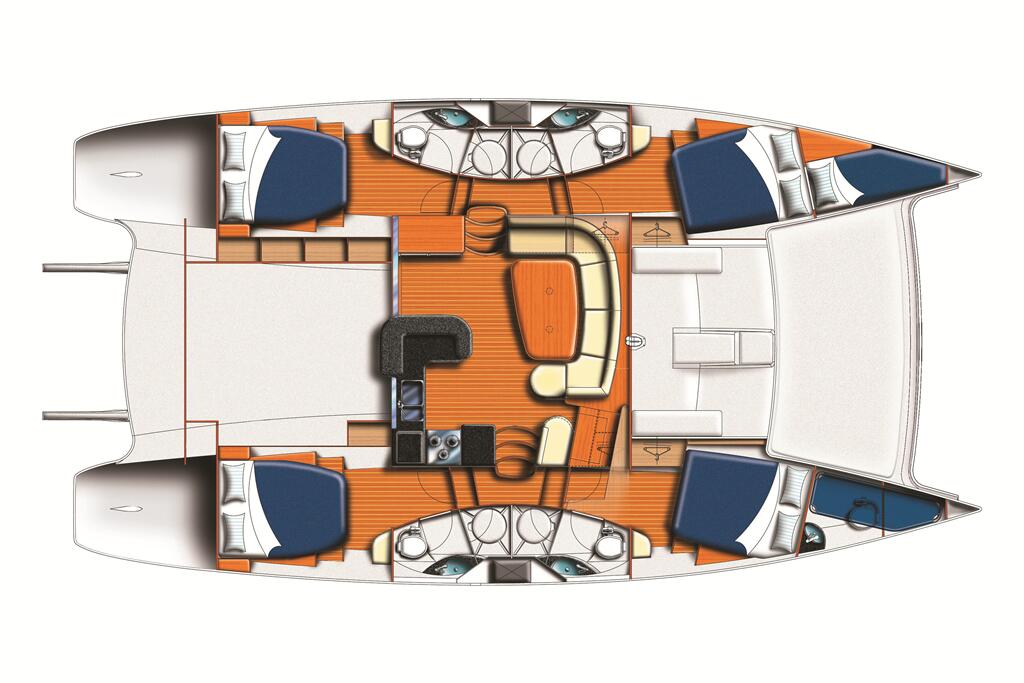
Specifications
- Design Name: Leopard 474PC Powercat
- Year Launched: 2008
- Designer: Morrelli & Melvin
- Interior Designer: Morrelli & Melvin
- Builder: Robertson and Caine
- LOA: 14.42m
- Beam: 7.57m
- LWL: 14.38m
- Draft: 985mm
- Displacement: 14500kg
- Max Speed: 21 knots
- Cruise Speed: 12-15 knots
- Veneer/Plywood: Cherrywood
- Davit Crane: Robertson and Caine
- Stainless Steel Doors: Robertson and Caine
- Helm Chair: Robertson and Caine
- Price As Tested: 4-cabin version in QLD commercial survey – AUD$1,200,000




